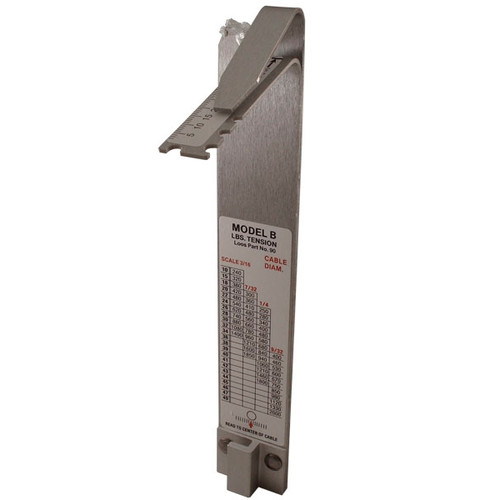Manufacturer part #: Model B - 90
| Part No. | Description |
|---|---|
| Model A-91 | Cable Sizes 3/32", 1/8", 5/32" |
| Model B - 90 | Cable Sizes 3/16", 7/32", 1/4", 9/32" |
| Metric - 91 | Cable Sizes 2.5mm, 3mm, 4mm |
| Metric - 90 | Cable Sizes 5mm, 6mm, 7mm |
The Loos economy tension gauge takes the guesswork out of cable tension adjustment. It's especially designed for accurate, repeatable tuning of a sailboat's standing rigging. Manufactured of rugged anodized aluminum, the gauge is corrosion-resistant and will provide years of service.
 To measure tension, simply hook the Loos gauge on the cable as illustrated (see picture above). Pull the lanyard (Blue arrow) until the pointer is positioned at the black calibration mark (red arrow), read the scale at the exact point where the middle of the cable touches the scale (white arrow). For best accuracy, the gauge should be held so that the scale barely touches the cable, thus eliminating friction.
To measure tension, simply hook the Loos gauge on the cable as illustrated (see picture above). Pull the lanyard (Blue arrow) until the pointer is positioned at the black calibration mark (red arrow), read the scale at the exact point where the middle of the cable touches the scale (white arrow). For best accuracy, the gauge should be held so that the scale barely touches the cable, thus eliminating friction.
A word of caution, however: excessive pull on the lanyard, which pulls the pointer beyond the calibration mark, may permanently bend the spring and damage the gauge.
To convert the scale reading to actual tension in pounds for each wire diameter, see the conversion table on the gauge.
How Much Tension
Table 1 recommends an initial tension setting, but there is no simple solution since the optimum rigging tension will be a function of the boat design, the rig (masthead or fractional, one or more spreaders, etc.), and even the cut of the sails. Many skippers use insufficient tension because of a fear of "breaking something." It should be noted that on America's Cup contenders, where electronic state of the art tension instrumentation is available, the standing rigging is set as tight as is structurally feasible.
| Table 1 | |||
|---|---|---|---|
| 302/304 1x19 Stainless Steel Rigging Cable | |||
| Ø In. | Breaking Strength Pounds | Forestay* Pounds | Shrouds* Pounds |
| 3/32 | 1200 | 180 | 120 |
| 1/8 | 2100 | 320 | 240 |
| 5/32 | 3300 | 500 | 350 |
| 3/16 | 4700 | 750 | 500 |
| 7/32 | 6300 | 1000 | 700 |
| 1/4 | 8200 | 1300 | 850 |
| 9/32 | 10300 | 1600 | 1050 |
| 5/16 | 12500 | 2000 | 1300 |
| 3/8 | 17500 | 2750 | 1850 |
* Suggested initial settings.
One Design Class Racing Sailboats
Most sail makers who produce sails for the one design classes provide each purchaser with specific set of readings on theLoos Model A or Model B tension gauges for use when setting up the standing rigging. This assures that the sails will have the correct shape when the rig is under load.
For the convenience of sailors who wish to upgrade from our Model A or B gauges to the professional model (PT-1, PT-2, or PT-3) gauges we include below a conversion chart so that the same recommended tension can be obtained with the PT-1, PT-2 or PT-3 gauges as with the Model A or B gauges.
| Model A | Model Pt-1 | Model B | Model Pt-2 | Model Pt-3 | ||||
|---|---|---|---|---|---|---|---|---|
| 3/32 | 1/8 | 5/32 | SCALE | 3/16 | 7/32 | 1/4 | 9/32 | |
| 5 | 6 | 10 | 11 | |||||
| 10 | 9 | 15 | 13 | |||||
| 15 | 12 | 14 | 18 | 15 | ||||
| 20 | 16 | 16 | 20 | 16 | 18 | |||
| 25 | 20 | 19 | 22 | 18 | 20 | |||
| 28 | 23 | 21 | 24 | 19 | 22 | |||
| 30 | 22 | 26 | 21 | 24 | ||||
| 35 | 27 | 25 | 28 | 23 | 25 | |||
| 38 | 30 | 28 | 30 | 25 | 27 | 25 | ||
| 40 | 33 | 30 | 32 | 27 | 29 | 27 | ||
| 42 | 33 | 34 | 29 | 31 | 39 | |||
| 44 | 36 | 36 | 33 | 31 | ||||
| 45 | 38 | 38 | 36 | 33 | 6 | |||
| 46 | 39 | 39 | 37 | 34 | 7 | |||
| 47 | 40 | 40 | 36 | 9 | ||||
| 41 | 37 | 10 | ||||||
| 42 | 39 | 11 | ||||||
| 43 | 40 | 12 | ||||||
| 44 | 14 | |||||||
| 45 | 16 | |||||||
| 46 | 18 | |||||||
| 47 | 20 | |||||||
| 49 | 25 | |||||||
1 Review Hide Reviews Show Reviews
-
Loos Tension Gauge
Very good Quality! Fast Shipping and great support! My new home for my sailboat rigging! They even made a new custom headstay for my S2 7.9 at a very reasonable price for a top quality replacement! I am very happy I found this Company!





